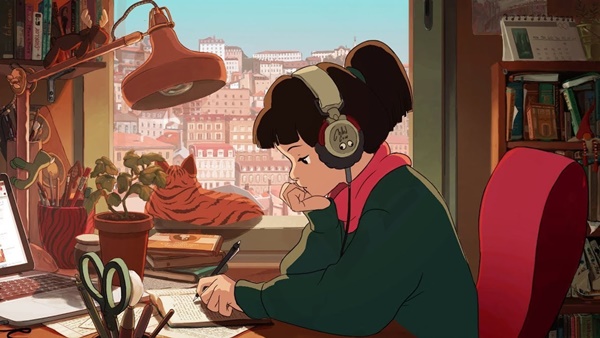Anime and music are inextricably linked. In Japan “anisongs”- anime theme songs – are a genre unto themselves; a broad one spanning rock, pop and categories in between. Artists regularly score chart-topping hits with themes to animated films and tv series such as LiSA’s smash “Gurenge” for the anime juggernaut Demon Slayer: Kumetsu No Yaiba. Joe Hisaishi’s scores for the Studio Ghibli films of Hayao Miyazaki have grown internationally iconic, and at this point are nearly a genre unto themselves. Thanks to the work of anime director Shinichiro Watanabe, and a cult following on YouTube, the niche musical genre lo-fi is forever linked to anime.
What is lo-fi?
Lo-fi is short for ‘low fidelity’, referring to sound quality. Originally, it referred to music recorded “on the cheap” with subpar recording equipment and in unconventional spaces, like the musicians’ homes. Derided throughout the 60s and 70s, lo-fi’s DIY nature struck a chord with then nascent musical art forms like hip-hop and punk in the 1980s and ’90s. Early hip hop, especially, embraced lo-fi tactics like the sound of scratched vinyl augmenting otherwise mellow beats.
Cowboy BeBop and Samurai Champloo
In 1997, the anime Cowboy Bebop premiered. Directed by anime director Shinichiro Watanabe, the anime is a genre-bending mash-up of the western, film noir, and cyberpunk genres with a dash of existential philosophy. Upon being aired on Cartoon Network’s Adult Swim line-up, itself a groundbreaking block of animated series aimed at adult audiences, Cowboy Bebop quickly became seminal amongst Western viewers. Its soundtrack, composed by Japanese composer Yoko Kanno, featured modern takes on one of lo-fi’s bedrock genres, jazz, with elements of rock, pop, folk, and electronic music.
Watanabe ventured even further into lo-fi territory with the soundtrack of his 2004 anime, Samurai Champloo, a referential modern take on an Edo era samurai tale. The soundtrack featured original music by lo-fi hip hop artists Shakkazombie, Fat Jon, Nujabes, and FORCE OF NATURE. Watanabe’s anachronistic anime soundtracks were reflections of the genres and sounds he, himself, was preoccupied with, but the exposure garnered by Cowboy Bebop’s airing on Adult Swim, and Samurai Champloo’s run on the network’s legendary Toonami anime block, cemented the tie between lo-fi music and anime in the public imagination.
Lo-Fi Girl
This association continued into the present age, in which YouTube is rife with playlists of mellow mood music recommended for work and studying. In 2015, the YouTube account Chilled Cow began broadcasting lo-fi hip hop music. Their icon, a picture of a young girl at a desk studying, was dubbed “Lo-Fi Girl.” The character was originally a still of the protagonist of Miyazaki’s 1995 film Whisper of the Heart , but was altered into an original character dubbed “Lo Fi Girl” or “Anime Girl” by the account’s followers.
Conclusion
Many other such YouTube accounts with lo fi music, incorporating a wide range of genres and instrumentals, have sprung up in the wake of Chilled Cow, now called Lo Fi Girl after its icon. Lo-fi, like another niche genre that has found popularity on YouTube, city pop, has touched a chord with online music listeners. The character Lo-Fi Girl, intensely absorbed in her studies with a wistful look in her eye, is emblematic of those who seek out the genre, looking for a music that defies genre and calms the mind. Thanks to the groundbreaking soundtracks of Watanabe’s animes, lo-fi’s wabi sabi blend of genres and the art of anime go hand in hand.
More From LWOS Life
Make sure to stay tuned to LWOS Life for more on this and other stories from around the world of entertainment, culture and more, as they develop. You can always count on LWOS Life to be on top of the major news in the world of entertainment; whilst also providing you with editorials on everything from beer to movie reviews.

